Page 254 of 473
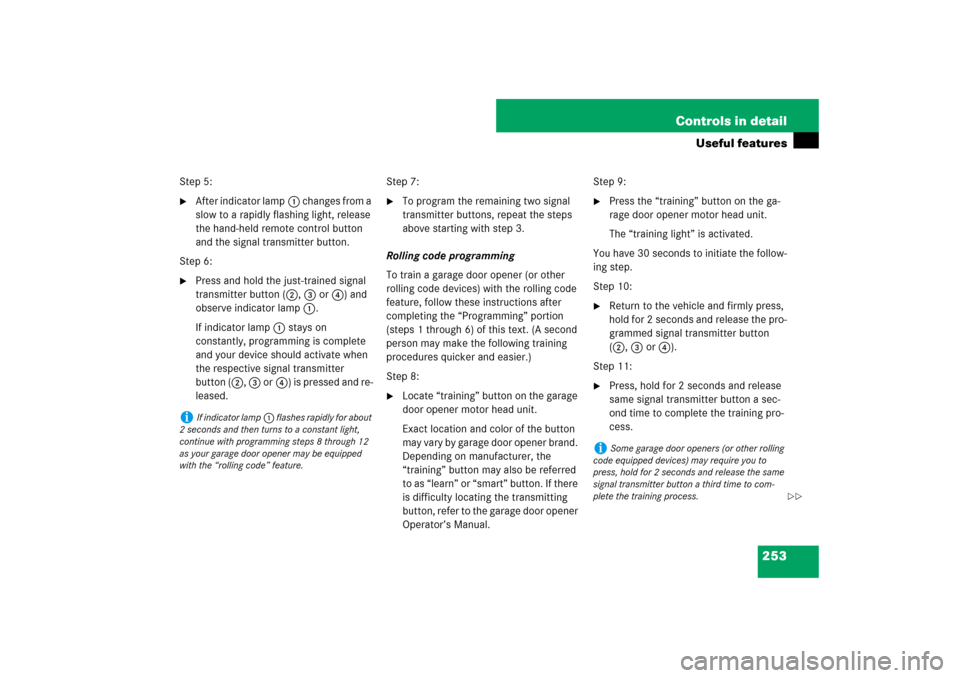
253 Controls in detail
Useful features
Step 5:�
After indicator lamp1 changes from a
slow to a rapidly flashing light, release
the hand-held remote control button
and the signal transmitter button.
Step 6:
�
Press and hold the just-trained signal
transmitter button (2, 3 or4) and
observe indicator lamp1.
If indicator lamp1 stays on
constantly, programming is complete
and your device should activate when
the respective signal transmitter
button (2, 3 or4) is pressed and re-
leased.Step 7:
�
To program the remaining two signal
transmitter buttons, repeat the steps
above starting with step 3.
Rolling code programming
To train a garage door opener (or other
rolling code devices) with the rolling code
feature, follow these instructions after
completing the “Programming” portion
(steps 1 through 6) of this text. (A second
person may make the following training
procedures quicker and easier.)
Step 8:
�
Locate “training” button on the garage
door opener motor head unit.
Exact location and color of the button
may vary by garage door opener brand.
Depending on manufacturer, the
“training” button may also be referred
to as “learn” or “smart” button. If there
is difficulty locating the transmitting
button, refer to the garage door opener
Operator’s Manual. Step 9:
�
Press the “training” button on the ga-
rage door opener motor head unit.
The “training light” is activated.
You have 30 seconds to initiate the follow-
ing step.
Step 10:
�
Return to the vehicle and firmly press,
hold for 2 seconds and release the pro-
grammed signal transmitter button
(2, 3 or4).
Step 11:
�
Press, hold for 2 seconds and release
same signal transmitter button a sec-
ond time to complete the training pro-
cess.
i
If indicator lamp1 flashes rapidly for about
2 seconds and then turns to a constant light,
continue with programming steps 8 through 12
as your garage door opener may be equipped
with the “rolling code” feature.
i
Some garage door openers (or other rolling
code equipped devices) may require you to
press, hold for 2 seconds and release the same
signal transmitter button a third time to com-
plete the training process.
��
Page 326 of 473
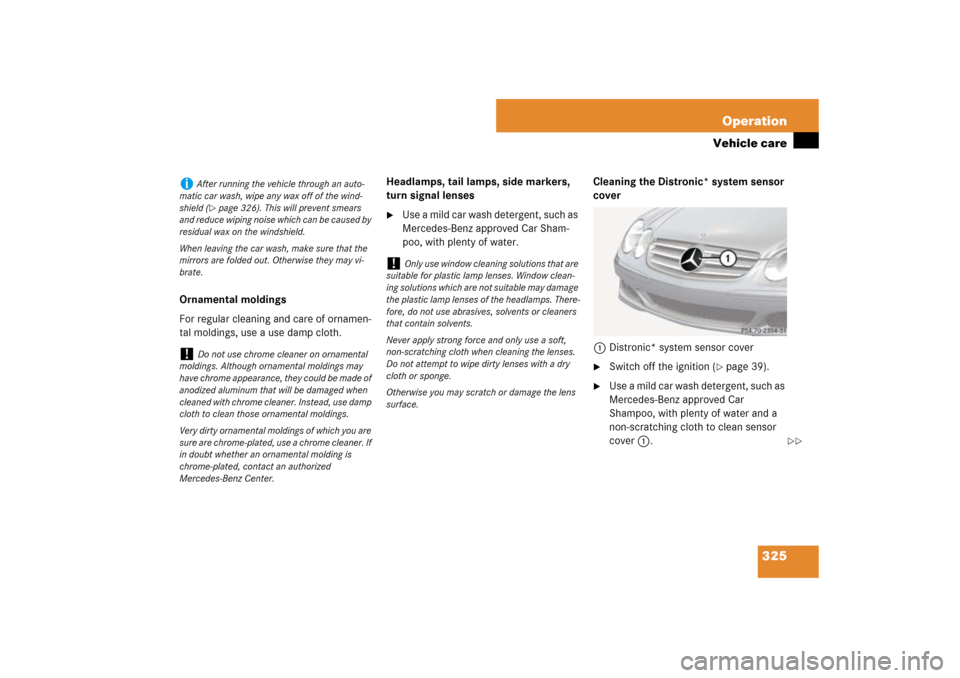
325 Operation
Vehicle care
Ornamental moldings
For regular cleaning and care of ornamen-
tal moldings, use a use damp cloth.Headlamps, tail lamps, side markers,
turn signal lenses
�
Use a mild car wash detergent, such as
Mercedes-Benz approved Car Sham-
poo, with plenty of water.Cleaning the Distronic* system sensor
cover
1Distronic* system sensor cover
�
Switch off the ignition (
�page 39).
�
Use a mild car wash detergent, such as
Mercedes-Benz approved Car
Shampoo, with plenty of water and a
non-scratching cloth to clean sensor
cover1.
i
After running the vehicle through an auto-
matic car wash, wipe any wax off of the wind-
shield (
�page 326). This will prevent smears
and reduce wiping noise which can be caused by
residual wax on the windshield.
When leaving the car wash, make sure that the
mirrors are folded out. Otherwise they may vi-
brate.
!
Do not use chrome cleaner on ornamental
moldings. Although ornamental moldings may
have chrome appearance, they could be made of
anodized aluminum that will be damaged when
cleaned with chrome cleaner. Instead, use damp
cloth to clean those ornamental moldings.
Very dirty ornamental moldings of which you are
sure are chrome-plated, use a chrome cleaner. If
in doubt whether an ornamental molding is
chrome-plated, contact an authorized
Mercedes-Benz Center.
!
Only use window cleaning solutions that are
suitable for plastic lamp lenses. Window clean-
ing solutions which are not suitable may damage
the plastic lamp lenses of the headlamps. There-
fore, do not use abrasives, solvents or cleaners
that contain solvents.
Never apply strong force and only use a soft,
non-scratching cloth when cleaning the lenses.
Do not attempt to wipe dirty lenses with a dry
cloth or sponge.
Otherwise you may scratch or damage the lens
surface.
��
Page 349 of 473
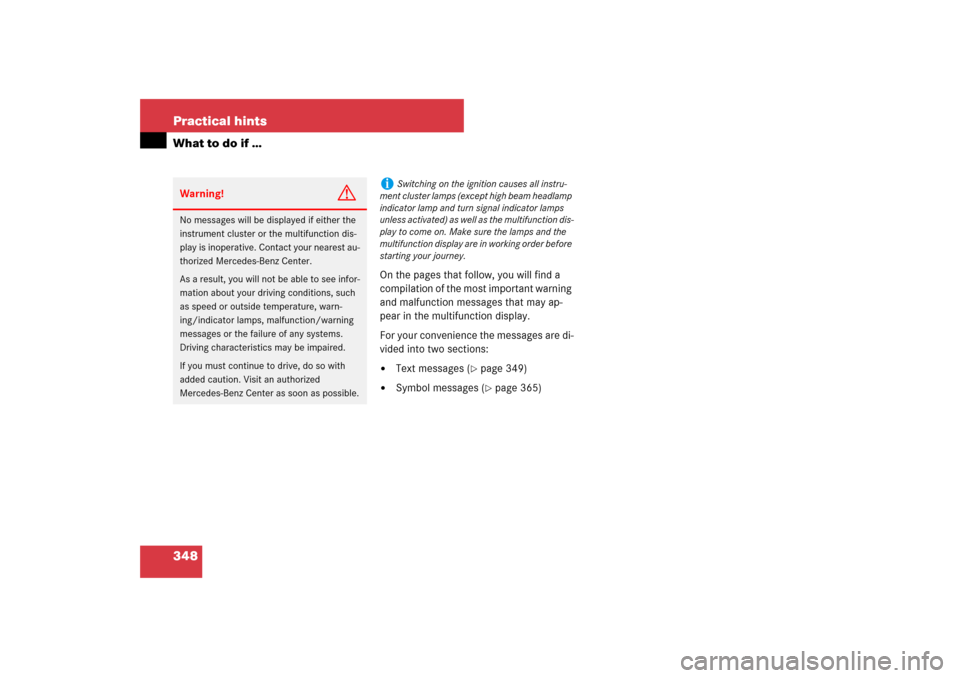
348 Practical hintsWhat to do if …
On the pages that follow, you will find a
compilation of the most important warning
and malfunction messages that may ap-
pear in the multifunction display.
For your convenience the messages are di-
vided into two sections:�
Text messages (
�page 349)
�
Symbol messages (
�page 365)
Warning!
G
No messages will be displayed if either the
instrument cluster or the multifunction dis-
play is inoperative. Contact your nearest au-
thorized Mercedes-Benz Center.
As a result, you will not be able to see infor-
mation about your driving conditions, such
as speed or outside temperature, warn-
ing/indicator lamps, malfunction/warning
messages or the failure of any systems.
Driving characteristics may be impaired.
If you must continue to drive, do so with
added caution. Visit an authorized
Mercedes-Benz Center as soon as possible.
i
Switching on the ignition causes all instru-
ment cluster lamps (except high beam headlamp
indicator lamp and turn signal indicator lamps
unless activated) as well as the multifunction dis-
play to come on. Make sure the lamps and the
multifunction display are in working order before
starting your journey.
Page 383 of 473
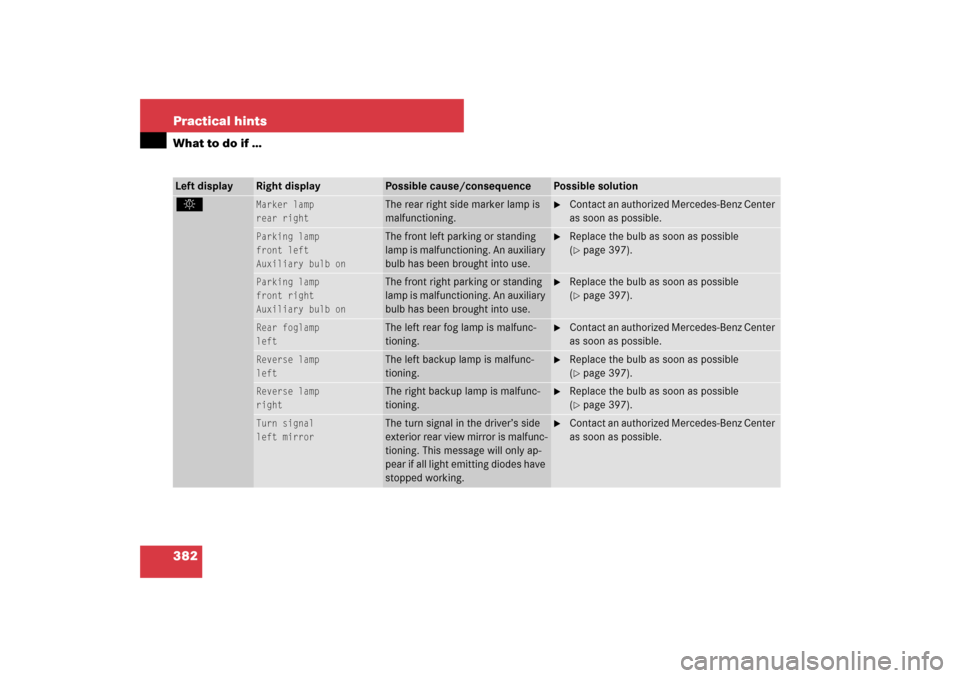
382 Practical hintsWhat to do if …Left display
Right display
Possible cause/consequence
Possible solution
.
Marker lamp
rear right
The rear right side marker lamp is
malfunctioning.
�
Contact an authorized Mercedes-Benz Center
as soon as possible.
Parking lamp
front left
Auxiliary bulb on
The front left parking or standing
lamp is malfunctioning. An auxiliary
bulb has been brought into use.
�
Replace the bulb as soon as possible
(�page 397).
Parking lamp
front right
Auxiliary bulb on
The front right parking or standing
lamp is malfunctioning. An auxiliary
bulb has been brought into use.
�
Replace the bulb as soon as possible
(�page 397).
Rear foglamp
left
The left rear fog lamp is malfunc-
tioning.
�
Contact an authorized Mercedes-Benz Center
as soon as possible.
Reverse lamp
left
The left backup lamp is malfunc-
tioning.
�
Replace the bulb as soon as possible
(�page 397).
Reverse lamp
right
The right backup lamp is malfunc-
tioning.
�
Replace the bulb as soon as possible
(�page 397).
Turn signal
left mirror
The turn signal in the driver’s side
exterior rear view mirror is malfunc-
tioning. This message will only ap-
pear if all light emitting diodes have
stopped working.
�
Contact an authorized Mercedes-Benz Center
as soon as possible.
Page 384 of 473

383 Practical hints
What to do if …
Left display
Right display
Possible cause/consequence
Possible solution
.
Turn signal
right mirror
The turn signal in the passenger
side exterior rear view mirror is mal-
functioning. This message will only
appear if all light emitting diodes
have stopped working.
�
Contact an authorized Mercedes-Benz Center
as soon as possible.
Tail lamp
left
Auxiliary bulb on
The left tail lamp is malfunctioning.
An auxiliary bulb has been brought
into use.
�
Contact an authorized Mercedes-Benz Center
as soon as possible.
Tail lamp
right
Auxiliary bulb on
The right tail lamp is malfunction-
ing. An auxiliary bulb has been
brought into use.
�
Contact an authorized Mercedes-Benz Center
as soon as possible.
Turn off
lights
You have removed the SmartKey
from the starter switch and opened
the driver’s door or removed the
SmartKey with KEYLESS-GO* from
the vehicle and left the headlamps
on.
�
Turn the exterior lamp switch toM
orU.
Turn signal
front left
Auxiliary bulb on
The left front turn signal lamp is
malfunctioning. An auxiliary bulb
has been brought into use.
�
Replace the bulb as soon as possible
(�page 397).
Turn signal
front right
Auxiliary bulb on
The right front turn signal lamp is
malfunctioning. An auxiliary bulb
has been brought into use.
�
Replace the bulb as soon as possible
(�page 397).
Page 385 of 473
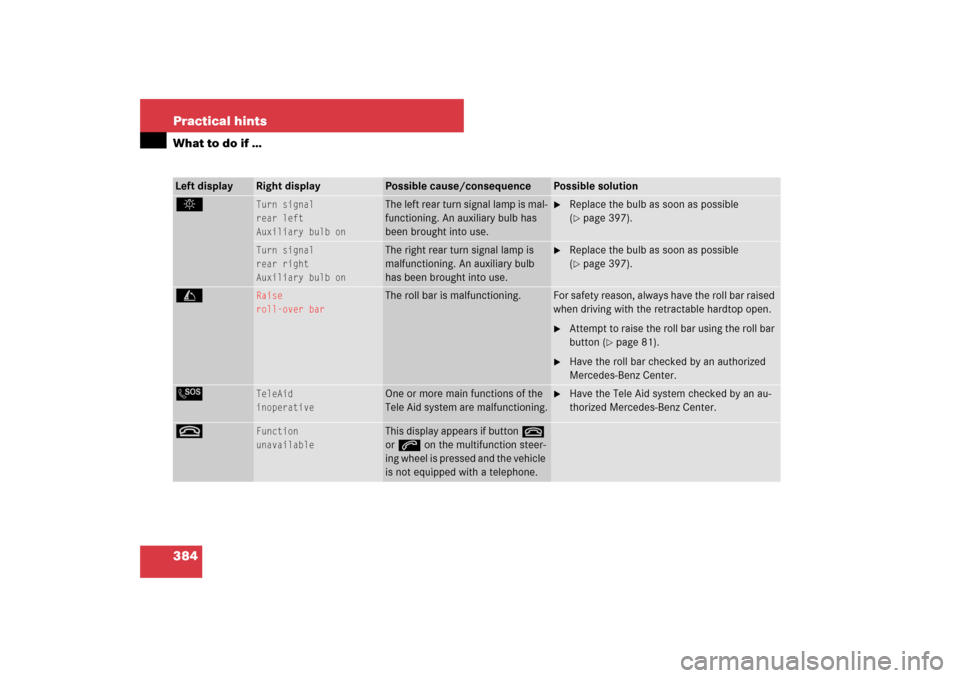
384 Practical hintsWhat to do if …Left display
Right display
Possible cause/consequence
Possible solution
.
Turn signal
rear left
Auxiliary bulb on
The left rear turn signal lamp is mal-
functioning. An auxiliary bulb has
been brought into use.
�
Replace the bulb as soon as possible
(�page 397).
Turn signal
rear right
Auxiliary bulb on
The right rear turn signal lamp is
malfunctioning. An auxiliary bulb
has been brought into use.
�
Replace the bulb as soon as possible
(�page 397).
C
Raise
roll-over bar
The roll bar is malfunctioning.
For safety reason, always have the roll bar raised
when driving with the retractable hardtop open.�
Attempt to raise the roll bar using the roll bar
button (
�page 81).
�
Have the roll bar checked by an authorized
Mercedes-Benz Center.
L
TeleAid
inoperative
One or more main functions of the
Tele Aid system are malfunctioning.
�
Have the Tele Aid system checked by an au-
thorized Mercedes-Benz Center.
t
Function
unavailable
This display appears if button t
or s on the multifunction steer-
ing wheel is pressed and the vehicle
is not equipped with a telephone.
Page 398 of 473
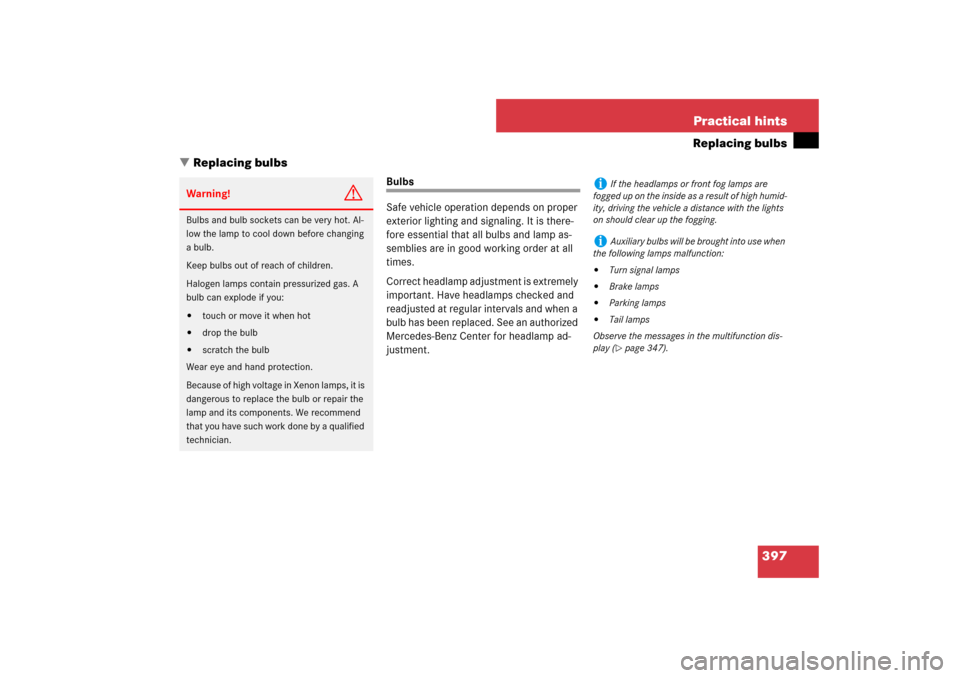
397 Practical hints
Replacing bulbs
�Replacing bulbs
Bulbs
Safe vehicle operation depends on proper
exterior lighting and signaling. It is there-
fore essential that all bulbs and lamp as-
semblies are in good working order at all
times.
Correct headlamp adjustment is extremely
important. Have headlamps checked and
readjusted at regular intervals and when a
bulb has been replaced. See an authorized
Mercedes-Benz Center for headlamp ad-
justment.
Warning!
G
Bulbs and bulb sockets can be very hot. Al-
low the lamp to cool down before changing
a bulb.
Keep bulbs out of reach of children.
Halogen lamps contain pressurized gas. A
bulb can explode if you:�
touch or move it when hot
�
drop the bulb
�
scratch the bulb
Wear eye and hand protection.
Because of high voltage in Xenon lamps, it is
dangerous to replace the bulb or repair the
lamp and its components. We recommend
that you have such work done by a qualified
technician.
i
If the headlamps or front fog lamps are
fogged up on the inside as a result of high humid-
ity, driving the vehicle a distance with the lights
on should clear up the fogging.
i
Auxiliary bulbs will be brought into use when
the following lamps malfunction:
�
Turn signal lamps
�
Brake lamps
�
Parking lamps
�
Tail lamps
Observe the messages in the multifunction dis-
play (�page 347).
Page 399 of 473
398 Practical hintsReplacing bulbsFront lamps Rear lamps
Lamp
Type
1
Additional turn signal
LED
2
Turn signal lamp
1156 NA
3
Low beam
1
1Vehicles with Xenon or Bi-Xenon* headlamps:
Low beam and high beam use the same D2S-35W
lamp. Do not replace the Xenon and Bi-Xenon*
bulbs yourself. Contact an authorized
Mercedes-Benz Center.
D2S-35 W
4
Xenon headlamp:
High beam, high beam
flasher
H7 (55 W)
Bi-Xenon headlamp*:
High beam flasher
H7 (55 W)
Parking and standing
lamp
W 5 W
5
Front fog lamp, Cor-
ner-illuminating front
fog lamp
H11 (55 W)
6
Side marker lamp
W 5 W
Lamp
Type
7
Rear fog lamp
(driver’s side only)
P 21 W
8
High mounted brake
lamp
LED
9
Backup lamp
P 21 W
a
Tail, parking and
standing lamp, side
marker lamp
LED
b
Brake lamp
LED
c
License plate lamp
C 5 W
d
Turn signal lamp
PY 21 W